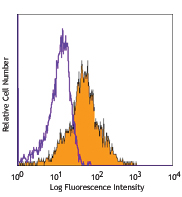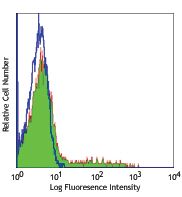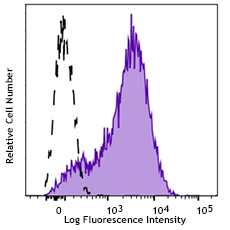- Clone
- BA5b (See other available formats)
- Regulatory Status
- RUO
- Workshop
- VI N-L078
- Other Names
- ADA-binding protein, DPP IV ectoenzyme, EC 3.4.14.5
- Isotype
- Mouse IgG2a, κ
- Ave. Rating
- Submit a Review
- Product Citations
- 15 publications

| Cat # | Size | Price | Quantity Check Availability | Save | ||
|---|---|---|---|---|---|---|
| 302704 | 100 tests | 169€ | ||||
CD26 is a 110 kD type II membrane protein also known as ADA-binding protein and dipeptidyl peptidase IV (DPPIV). It is a member of the peptidase and ectoenzyme family. CD26 is expressed on the membrane of mature thymocytes, T lymphocytes (upregulated upon activation), B cells, NK cells, and macrophages. CD26 cleaves off N-terminal X-Pro and X-Ala dipeptides from polypeptides. It plays an integral role as a costimulatory molecule in T cell activation. CD26 may interact with extracellular matrix proteins such as fibronectin or collagen, CD45 and ADA.
Product DetailsProduct Details
- Verified Reactivity
- Human
- Antibody Type
- Monoclonal
- Host Species
- Mouse
- Formulation
- Phosphate-buffered solution, pH 7.2, containing 0.09% sodium azide and BSA (origin USA)
- Preparation
- The antibody was purified by affinity chromatography, and conjugated with FITC under optimal conditions.
- Storage & Handling
- The antibody solution should be stored undiluted between 2°C and 8°C, and protected from prolonged exposure to light. Do not freeze.
- Application
-
FC - Quality tested
- Recommended Usage
-
Each lot of this antibody is quality control tested by immunofluorescent staining with flow cytometric analysis. For flow cytometric staining, the suggested use of this reagent is 5 µl per million cells in 100 µl staining volume or 5 µl per 100 µl of whole blood.
- Excitation Laser
-
Blue Laser (488 nm)
- Application References
-
- Kishimoto T, et al. Eds. 1997. Leucocyte Typing VI. Garland Press. London.
- Schlossman S, et al. Eds. 1995. Leucocyte Typing V. Oxford University Press. New York.
- Product Citations
-
- RRID
-
AB_314288 (BioLegend Cat. No. 302704)
Antigen Details
- Structure
- Peptidases and ectoenzyme families, type II glycoprotein, 110 kD
- Distribution
-
Thymocyte subset, memory T cells, B cells, NK cells, epithelial cells, macrophages
- Function
- Dipeptidyl peptidase, T cell costimulation, HIV entry
- Ligand/Receptor
- Adenosine-deaminase, collagen
- Cell Type
- B cells, Epithelial cells, Macrophages, NK cells, T cells, Thymocytes
- Biology Area
- Costimulatory Molecules, Immunology
- Molecular Family
- CD Molecules
- Antigen References
-
1. Kameoka J, et al. 1993. Science 261:466.
2. Dang N, et al. 1990. J. Exp. Med. 172:649. - Gene ID
- 1803 View all products for this Gene ID
- UniProt
- View information about CD26 on UniProt.org
Related FAQs
Other Formats
View All CD26 Reagents Request Custom Conjugation| Description | Clone | Applications |
|---|---|---|
| FITC anti-human CD26 | BA5b | FC |
| PE anti-human CD26 | BA5b | FC |
| PE/Cyanine5 anti-human CD26 | BA5b | FC |
| Purified anti-human CD26 | BA5b | FC |
| APC anti-human CD26 | BA5b | FC |
| PE/Cyanine7 anti-human CD26 | BA5b | FC |
| PerCP/Cyanine5.5 anti-human CD26 | BA5b | FC |
| Biotin anti-human CD26 | BA5b | FC |
| TotalSeq™-A0396 anti-human CD26 | BA5b | PG |
| TotalSeq™-C0396 anti-human CD26 | BA5b | PG |
| KIRAVIA Blue 520™ anti-human CD26 | BA5b | FC |
| TotalSeq™-B0396 anti-human CD26 | BA5b | PG |
| TotalSeq™-D0396 anti-human CD26 | BA5b | PG |
| FITC anti-human CD26 | BA5b | FC |
| PE anti-human CD26 | BA5b | FC |
| PE/Cyanine7 anti-human CD26 | BA5b | FC |
| Spark Red™ 718 anti-human CD26 (Flexi-Fluor™) | BA5b | FC |
| GMP FITC anti-human CD26 | BA5b | FC |
| GMP PE anti-human CD26 | BA5b | FC |
Customers Also Purchased
Compare Data Across All Formats
This data display is provided for general comparisons between formats.
Your actual data may vary due to variations in samples, target cells, instruments and their settings, staining conditions, and other factors.
If you need assistance with selecting the best format contact our expert technical support team.
-
FITC anti-human CD26

Human peripheral blood lymphocytes stained with BA5b FITC -
PE anti-human CD26

Human peripheral blood lymphocytes stained with BA5b PE -
PE/Cyanine5 anti-human CD26

Human peripheral blood lymphocytes stained with BA5b PE/Cyan... -
Purified anti-human CD26

Human peripheral blood lymphocytes stained with BA5b PE/Cyan... -
APC anti-human CD26

Human peripheral blood lymphocytes were stained with CD26 (c... -
PE/Cyanine7 anti-human CD26

Human peripheral blood lymphocytes were stained with CD26 (c... -
PerCP/Cyanine5.5 anti-human CD26

Human peripheral blood lymphocytes were stained with CD26 (c... -
Biotin anti-human CD26

Human peripheral blood lymphocytes were stained with biotiny... -
TotalSeq™-A0396 anti-human CD26
-
TotalSeq™-C0396 anti-human CD26
-
KIRAVIA Blue 520™ anti-human CD26

Human peripheral blood lymphocytes were stained with CD3 APC... -
TotalSeq™-B0396 anti-human CD26
-
TotalSeq™-D0396 anti-human CD26
-
FITC anti-human CD26

Typical results from human peripheral blood lymphocytes stai... -
PE anti-human CD26

Typical results from human peripheral blood lymphocytes stai... -
PE/Cyanine7 anti-human CD26

Typical results from human peripheral blood lymphocytes stai... -
Spark Red™ 718 anti-human CD26 (Flexi-Fluor™)
-
GMP FITC anti-human CD26

Typical results from human peripheral blood lymphocytes stai... -
GMP PE anti-human CD26

Typical results from human peripheral blood lymphocytes stai...


 Login / Register
Login / Register 






















Follow Us